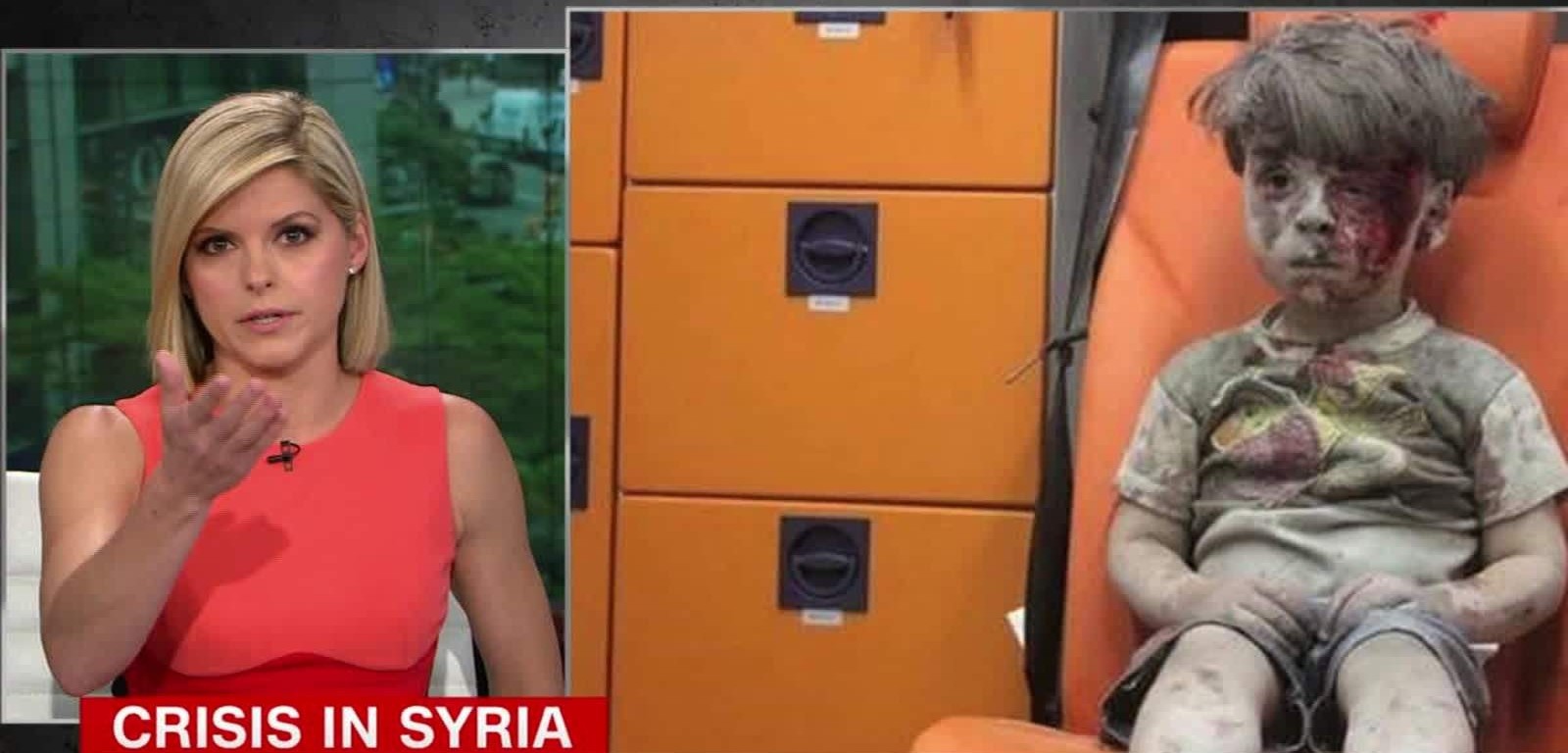Like millions of others around the world, I was recently taken by a shared post of a Mediaite.com article about a little boy, Omran Danqueesh, pulled from the rubble of his just-destroyed home in war-torn Aleppo, Syria. However, I must admit, what hooked me into clicking and reading the post was more than likely not the sad, common reality of a child injured in a war zone, but instead the less ubiquitous specter of a national news anchor choking back tears while telling the story.
In fact, the article by Lindsey Ellefson, like many subsequent articles featured on many other outlets over the next several days, actually focused more on the crying news anchor than the injured child. The very first sentence is descriptive of CNN anchor Kate Bolduan’s reputation as a tough and emphatic reporter. It goes on briefly to describe the images that Bolduan is referencing in her report and nods even more briefly at the genus of the air strike that blew up Omran’s home. What Ellefson does at that point is akin to a sportscaster shutting up and letting the images tell the story of what just happened in the game. She writes that there is no point in her describing the scene and instructs the reader to “watch (the video) right here for yourself” and embeds the clip there.
Standard YouTube License
The video did a good job of showing not only the emotional reporter’s struggle with her delivery, but also, thankfully, the chaotic scene of the air strike, and described in Bolduan’s words both the story of Omran’s family and the dire situation in Aleppo.
As a journalistic piece, Ellefson’s article reeled me in with the headline and the premise, and she engaged me quickly by putting the CNN video clip up high in her piece. The video did live up to its promise by showing me a verklempt anchor, but it went beyond that superficiality by showing and telling me background information on the conflict in Syria, the abysmal current conditions in Aleppo, and the visceral human interest story of a little boy whose image is now likely to be among a pantheon that includes Kim Phúc and Elian Gonzalez.


It was Bolduan’s reporting, of course, not Ellefson’s, that engaged me to the point of shedding tears myself, but Ellefson was the one who brought it to my attention.
The Mediaite article does not seem to particularly adhere strictly to a standard story arc – although it does provide a “happy” resolution, of sorts, at the end by quoting Bolduan (“This is Omran. He’s alive. We wanted you to know.”) It also does not readily follow an inverted pyramid style of reporting either – although we don’t have to wait long for the video centerpiece. What Elllefson’s post does do, however, is, first, bring to light an instance of an anchor who cries while reporting a story, but then blows up into viral proportions the scenario of a reporter who now is the story.
I would say that in about 98% of the cases where that journalistic no-go boundary has been breached, the reporter (not to mention the reporter’s boss) is unhappy about the situation where the intended story is being upstaged. I have personally worked in newsrooms where News Director anger directed at self-highlighting reportage, whether intentional or not, was a real and scary thing. However, in this instance, I would offer the takeaway that Bolduan, CNN, and the citizens of Syria and all those trying to help them are glad that a few sincere tears in a place where they are normally not allowed may have helped bring desperately needed attention to a horrific humanitarian crisis.


War is uglier than evil itself . most people think war is what they see in movies.
LikeLike
Reblogged this on Chad T. Douglas and commented:
A great blog post about Omran Daqneesh and what his story means to countries around the world as well as to those directly suffering through the Syrian humanitarian crisis.
LikeLike
Fantastic story to highlight! This was a very good example of maximizing the impact with social news reporting. It is not too often that we see reporters emotionally shaken by what they are reporting. I remember though, during 9/11 many of the reporters had to cut away because they could not maintain composure. I think the article, and how it was presented, really showed how Ellefson regained control of the news and brought it back to Omran Danqueesh. War is a tough thing to be a part. It was tough for me and I was 18 during my first fire fight. He is so young and in an eerie way, undisturbed by the commotion. One of the most compelling parts of this video for me was the moment he wiped the blood from his head and looked at his hand. I am not sure why that had a profound impact on me, but it did. Thank you for bringing this story to my attention and sharing your thoughts. You delved deep into the material and applied what we now know about story telling methods. On top of showing your clear understanding of the composition of news articles, I really appreciated you incorporating your personal experience in the news room. I’ve never held a job like that in any capacity and would not have brought that level of awareness.
LikeLike